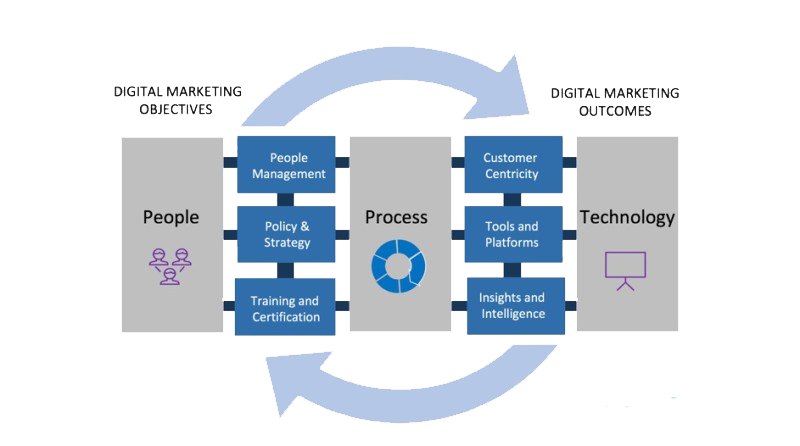What is a marketing centre of excellence and do you need one?

Recently, the American Marketing Association stated that “to keep up with marketing’s continuous evolution, companies could get a jump on their competitors by creating a centre of excellence”. But what does this mean, and how do you do it?
What do we mean by ‘Centre of Excellence’ (CoE)? Is it just another buzzword to add to the pile? Gartner defines a COE as “a physical or virtual center of knowledge concentrating existing expertise and resources in a discipline or capability to attain and sustain world-class performance and value”.
In essence, a CoE is a team that leads others in the organisation in a particular area of expertise, whether that be technology, skill or discipline. A CoE provides leadership, best practices, research, support and/or training. It breaks down silos and improves efficiency to the drive success of business critical metrics. So while it’s name may sound buzzwordy, it’s definition isn’t a fad.
Do we need a marketing CoE?
So how do you figure out if your company needs to build a Marketing Centre of Excellence (CoE)? This answer is likely to be yes if your organisation needs to improve specific marketing capabilities that are important for critical business results such as revenue growth.
It’s also a yes if you require your marketers to have knowledge about a particular area (such as customer experience) and the knowledge is difficult to acquire, or if centralised processes would improve performance.
What does it look like?
A CoE is more than simply centralising your marketing functions. In the below diagram, Jim Yu, founder of BrightEdge, has identified three key steps in the development of a Digital Marketing CoE.

Those of you who regularly read our blog may already be aware of DEPT® UK’s ‘four Ps’ for digital transformation (People, Platform, Process, Performance), and will see how these are applicable for CoE development. The two are very closely interlinked – a CoE facilitates the operational changes needed for true digital transformation.
People
Finding, developing and retaining talent is the most important part of establishing a CoE. 31% of respondents to a recent marketing survey by Accenture said that they weren’t satisfied with the digital skillsets of their employees, and a whopping 93% of UK public sector organisations find digital skills a challenging area, according to a report by Deloitte.
To achieve CoE success, marketing teams should be made up both specialist and hybrid roles. According to Jim Yu, this, combined with agile mindsets, can create a fluid digital presence for an organisation.
Employees need to be able to adapt and learn new skills, taking on new roles as marketing techniques and technology advances. Only then can an organisation maximise its investment digital solutions.
Process
Business models and sales objectives sit at the heart of the CoE; everything should be centred on your organisation’s needs. A CoE’s primary focus is to push beyond standard performance norms to deliver incremental value.
The processes employed should be geared towards breaking down silos and delivering a smooth integration between all of the specialist sub-groups within your CoE (such as creative, development, content etc) and, indeed, the wider organisation. In doing so, you will create a leaner, flexible and more agile organisation.
Governance is key. This will help the organisation with prioritisation, accountability and the establishment of policies and standards.
Technology
Spend on marketing technology is expected to increase ten-fold to $120bn in a decade’s time. The right technology stack, teamed with the correct skills and utilisations, can have a hugely positive impact on a company’s bottom line.
However, it’s a challenge to know the best technologies to invest in, deliver seamless integration and then ensure effective utilisation. As Jim Yu rightly points out, “When building a marketing technology stack, it’s imperative that performance marketing technology is central to the stack; vendors that focus on production, automation and process must feed into analytical and reporting technology that moves the needle on digital performance”.
It is the CoE’s responsibility to test new technologies and build performance-based business models, adopting the right technology at the right time to deliver integrated digital marketing activities.
Measuring success
Building a CoE takes considerable investment and it’s imperative that you establish clear criteria for the success of both the operational side of the CoE and its impact on the organisation. Success should be defined in terms of value to business.
Laura Patterson, President at VisionEdge Marketing, suggests basing success criteria around:
- Enforcing standard processes and best practices to improve time to market by X%, improve customer experience for A by X%, etc.
- Improving employee decision making, competency, and proficiency in X (such as analytics or metrics selection) resulting in Y improvement on time to decision.
- Improving quality in areas such as: quality of new opportunities, quality of the win rate, etc.
If your metrics are related to performance, productivity, customer value, competitiveness and cost, the results are sure to resonate with your C-suite.



